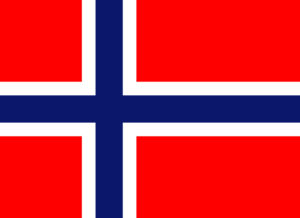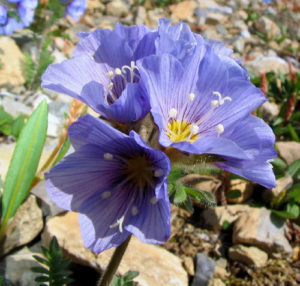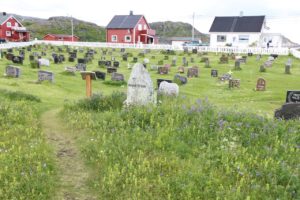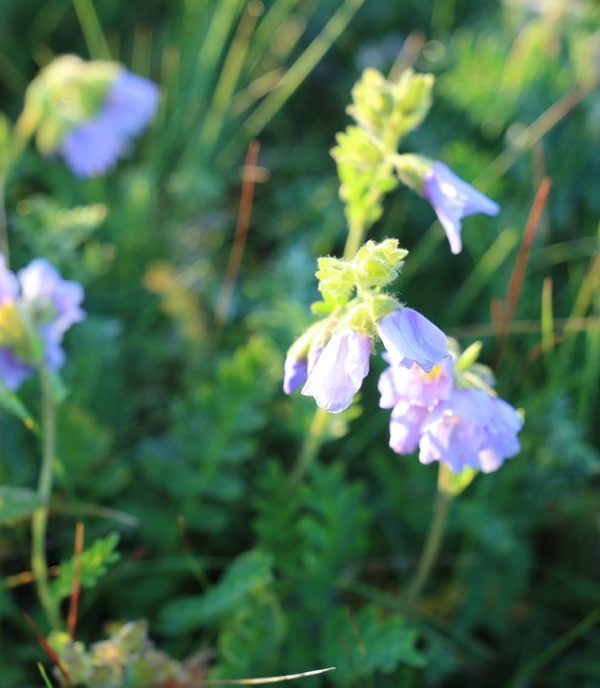 Polarflokk (Polemonium boreale)
Polarflokk (Polemonium boreale)
Utbredelse av polarflokk. (Polemonium boreal)
Polarflokk er kjent fra én lokalitet på Bugøynes i Øst-Finnmark, der den i dag er begrenset hovedsakelig til plenene på kirkegården. Den har neppe hatt noen større utbredelse, men er trolig gått tilbake i Bugøynes-området som følge av beiting.
Status
Kategori sterkt truet (CR) i Norsk rødliste for arter 2010.
Bestandsstatus: Rødlistet art
Kjennetegn
Polarflokk hører til flokkslekta i fjellflokkfamilien. Det finnes tre flokkarter i Norge: fjellflokk, lappflokk og polarflokk. Fjellflokk og lappflokk er nært beslektet mens polarflokk hører til en noe annen gruppe i slekta. Polarflokk er en flerårig urt med krypende jordstengel, oppstigende stengler opp til 20-30 cm, mangefinnete blad, særlig samlet ved grunnen av stenglene, og en kvastformet, nokså tett blomsterstand med flere store, blå, 5-tallige blomster med gul sentralflekk.
Utbredelse
Polarflokk har i dag i bare én forekomst på fastlandet i Norge, på Bugøynes i Finnmark. Det er lite trolig at arten noen gang har hatt noen større utbredelse i fastlands-Norge. Arten har en stor, arktisk sirkumpolar utbredelse i Nord- Kanada, Alaska og Nord-Russland med Sibir. Polarflokk er sjelden på Grønland og med nokså spredte forekomster på Svalbard. Forekomsten i Finnmark knytter seg til noen få forekomster nord på Kolahalvøya, og disse er en del av sørgrensa for arten.
Biologi
Polarflokk var opprinnelig knyttet til stabile sanddyner og sandbanker i Finnmark, men vokser i dag hovedsakelig på en kirkegård som er etablert på gammel sanddyne (plen). Arten er trolig noe basekrevende, og i Arktis er den også nitrogenelskende og finnes ofte i tilknytning til fugleberg. Arten er i hovedsak utkryssende og produserer ganske store frø uten spesielle spredningstilpasninger. Polarflokk er en hardfør arktisk plante, men ikke konkurransesterk i høgvokst vegetasjon.
Polarflokk vurderes som kritisk truet (CR) i fastlands-Norge på grunn av meget liten forekomst, sårbart voksested, og antatt genetisk forurensning. Polarflokk ble først funnet på Bugøynes av J. M. Norman på 1860-tallet og ble da angitt “i største mængde”. Arten må ha gått sterkt tilbake i perioden etter Normans oppdagelse, trolig som følge av beiting. Nå er arten begrenset til kirkegården, men i 1968 ble det påvist to små bestander også utafor kirkegården. På kirkegården er det innplantet fjellflokk (P. caeruleum). Hybridisering mellom polarflokk og fjellflokk er trolig en trussel, men dokumentasjon for reell introgresjon mangler. Populasjonen av polarflokk er liten og sterkt utsatt, til tross for at lokalbefolkningen er oppmerksom på den og beskytter den. Tidligere har den også vært utsatt for innsamling til herbarier. Det er over 60 innsamlinger fra den vesle forekomsten i norske offentlige herbarier, og sikkert like mange i utenlandske. Geografisk er Bugøynes-forekomsten en naturlig forlengelse vestover fra utbredelsen i Nord-Russland.
Tekst: Heidi Solstad og Reidar Elven, Naturhistorisk museum, Universitetet i Oslo
Foto: Wikipedia
 Polar Flock (Polemonium boreal)
Polar Flock (Polemonium boreal)
Proliferation of polar flock.
Polar flock is known from one locality on Bugøynes in eastern Finnmark, where it is currently limited mainly to the lawns in the cemetery. It has scarcely had any widespread spread, but has probably gone back in the Bugøynes area as a result of application.
Status
Category Strongly Threatened (CR) in the Norwegian Red List for Species 2010.
File Status: Red Listed Species
Characteristics
Polar flock are part of the mountain family. There are three species in Norway: mountain category, patch and polar category. Mountain category and patch is closely related. The polar group belongs to another group in the genus. Polar flora is a perennial herb with creeping rocks, ascending stems up to 20-30 cm, multifinished leaves, especially gathered at the base of the stalks, and a tassel-shaped, fairly dense inflorescence with several large blue, 5-tall flowers with yellow central spot.
Prevalence
Polar flock currently has only one occurrence on the mainland in Norway, on Bugøynes in Finnmark. It is unlikely that the species has ever had a wider spread in mainland Norway. The species has a large, arctic circumpolar propagation in northern Canada, Alaska and northern Russia with Siberia. Polar flags are rare in Greenland and with scattered deposits on Svalbard. The presence in Finnmark relates to a few instances north of the Kolahalvøya, and these are part of the southern border for the species.
Biology
Polar flock was originally linked to stable sand dunes and sand banks in Finnmark, but today it grows mainly in a cemetery established on old sand dune (lawn). The species is probably something basic, and in the Arctic it is also nitrogen-loving and often found in connection with bird mountains. The species is mainly tickling and produces quite large seeds without special dispersion adjustments. Polar category is a hardy arctic plant, but not competitive in high-growth vegetation.
Polar category is considered critically endangered (CR) in mainland Norway due to very low incidence, vulnerable habitat, and assumed genetic contamination. Polar category was first found on Bugøynes by J. M. Norman in the 1860s and was then declared «in the largest amount». The species must have gone back strongly in the period after Norman’s discovery, probably as a result of application. Now the species is confined to the cemetery, but in 1968 two small populations were also detected outside the cemetery. In the cemetery there is a planted mountain category (P. caeruleum). Hybridization between polar and mountain groups is probably a threat, but documentation for real introgression is missing. The population of the polar group is small and heavily exposed, despite the fact that the locals are aware of it and protect it. In the past, it has also been subjected to gathering for herbaries. There are more than 60 collections from the common occurrence in Norwegian public herbaries, and probably as many in foreign countries. Geographically, the Bugøynes incidence is a natural extension westward from the prevalence in northern Russia.
Text: Heidi Solstad and Reidar Elven, Natural History Museum, University of Oslo.
Photo: Wikipedia
Google trans.



